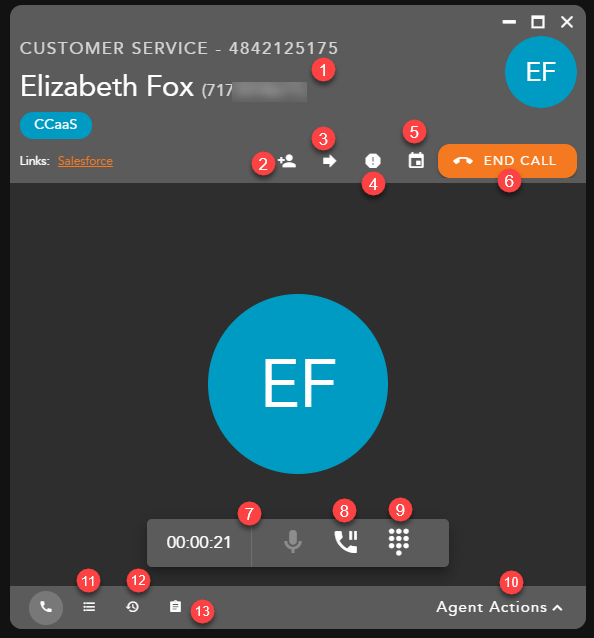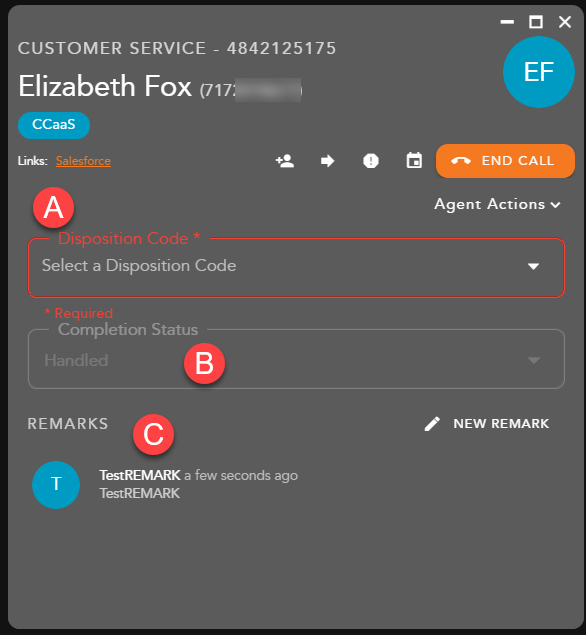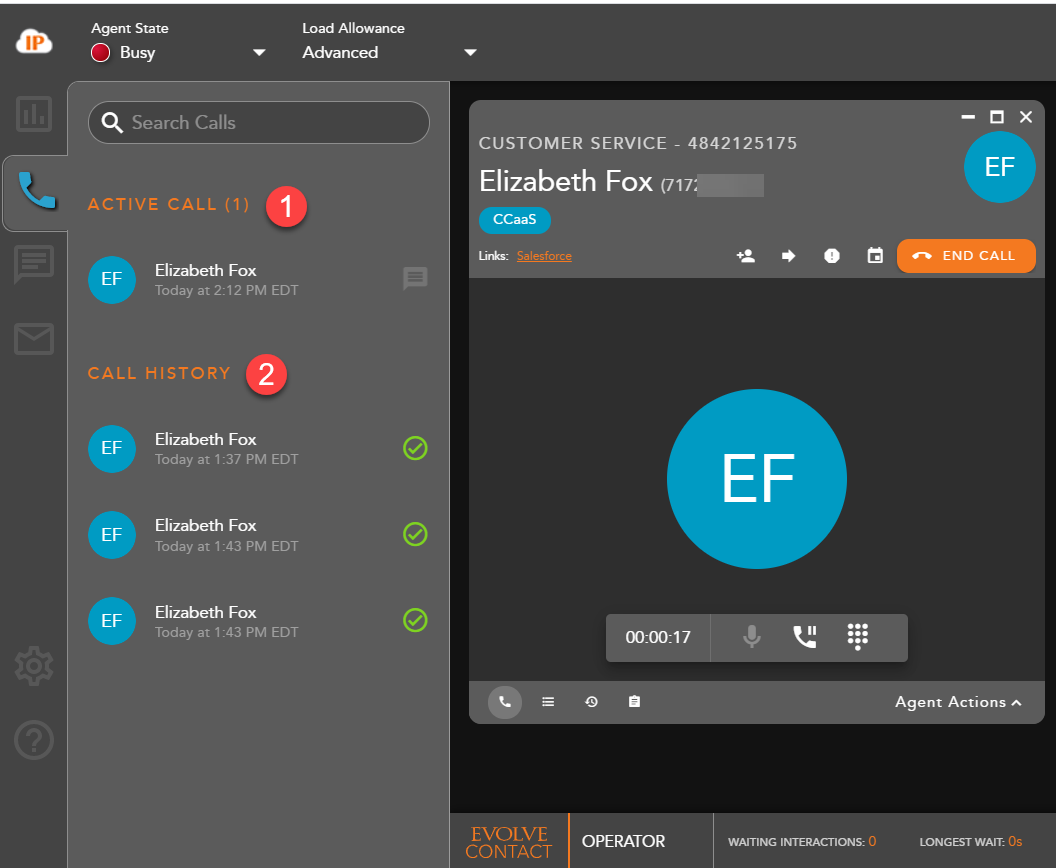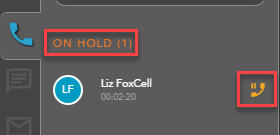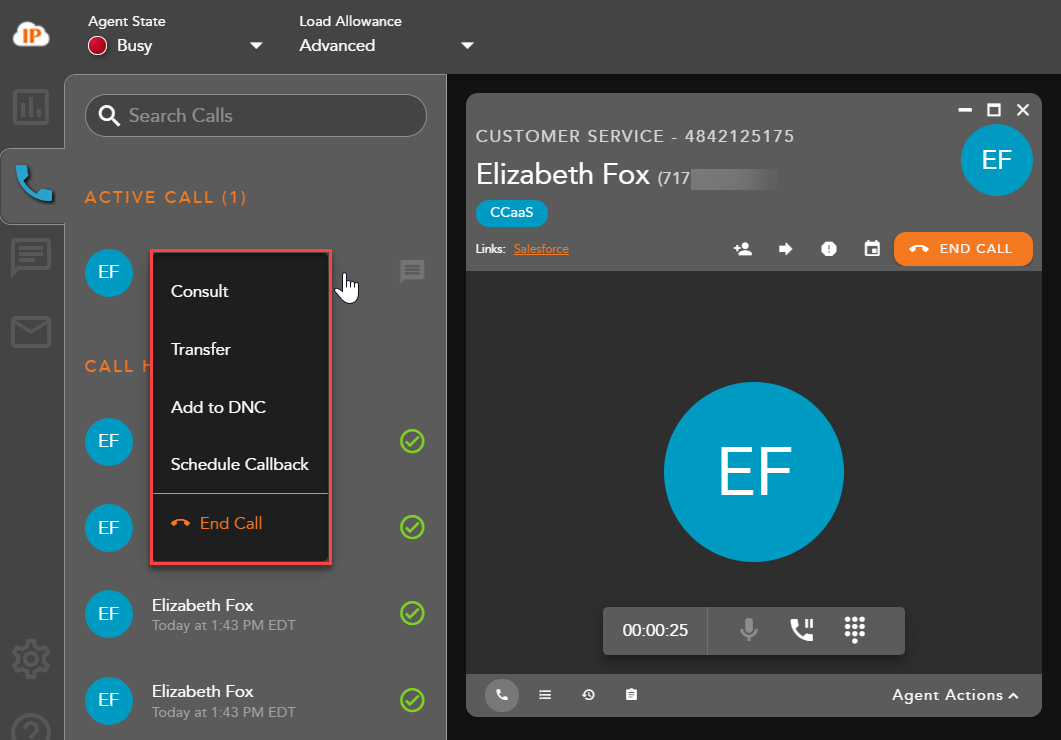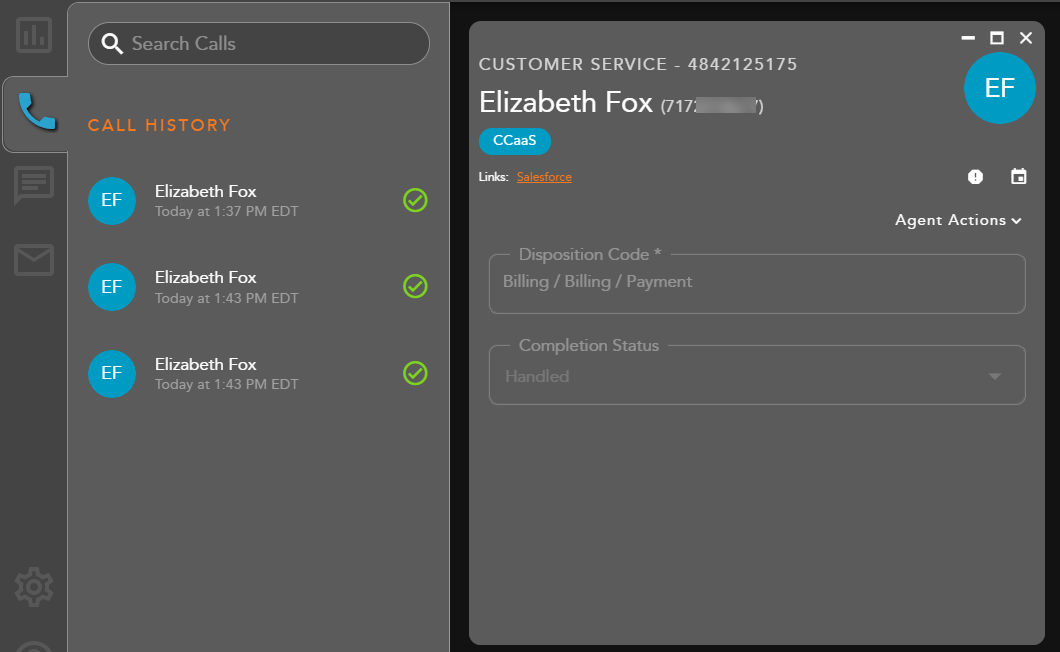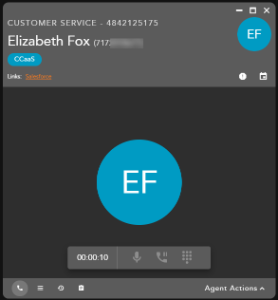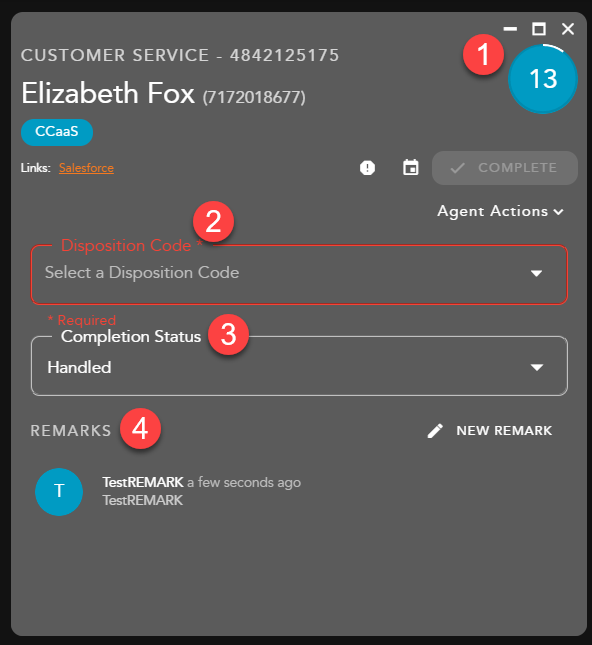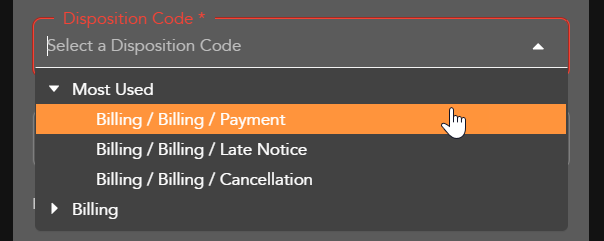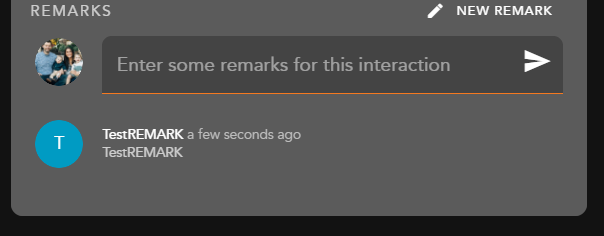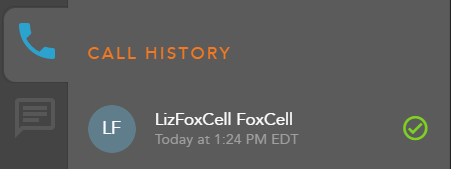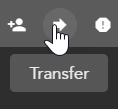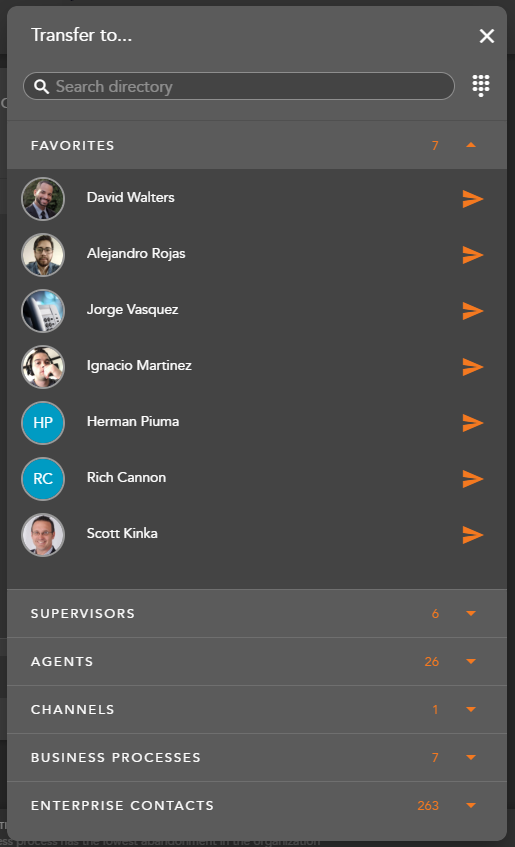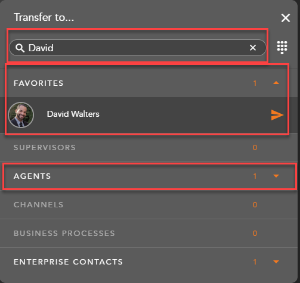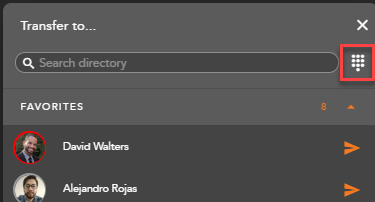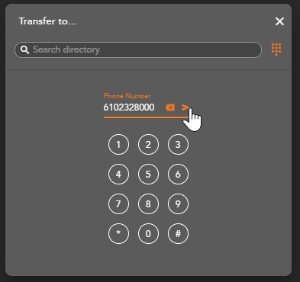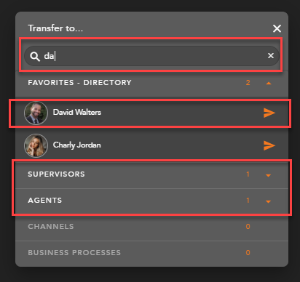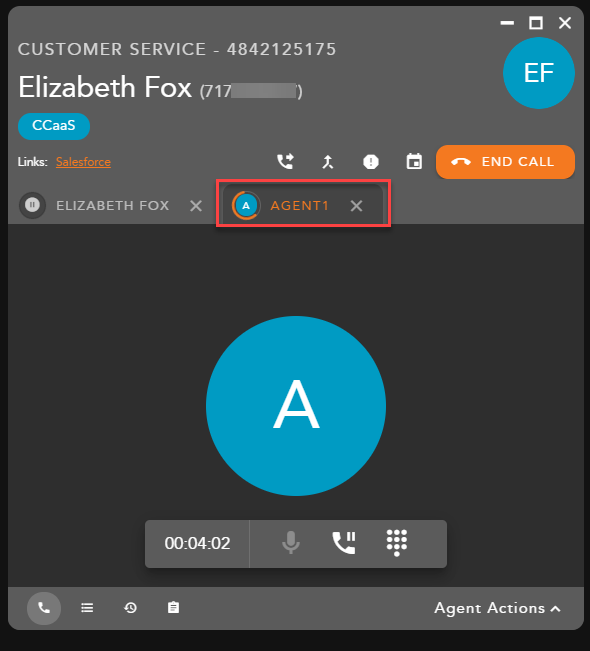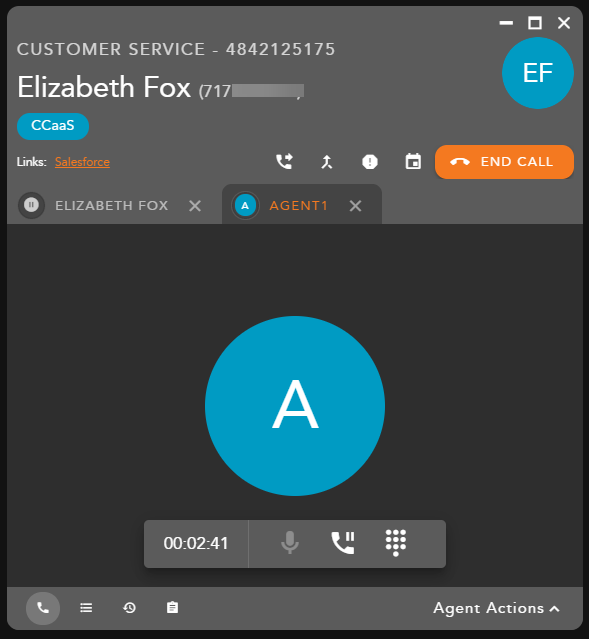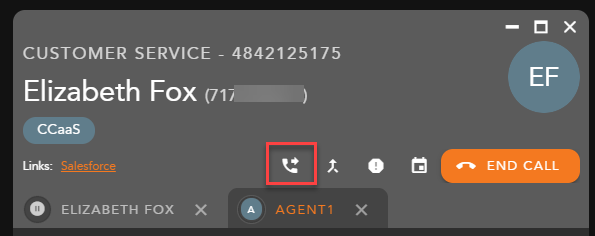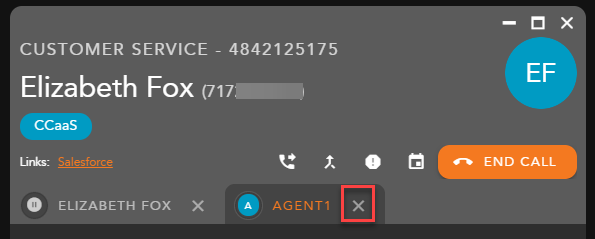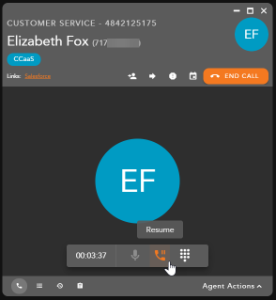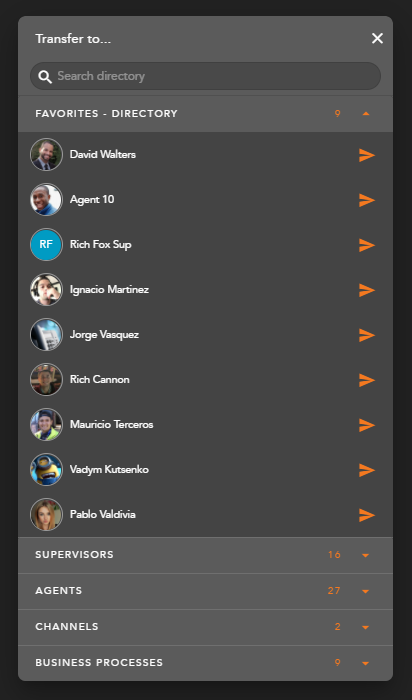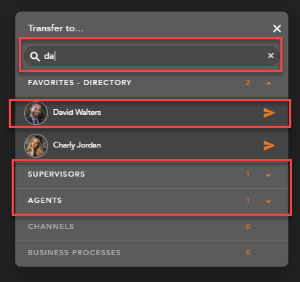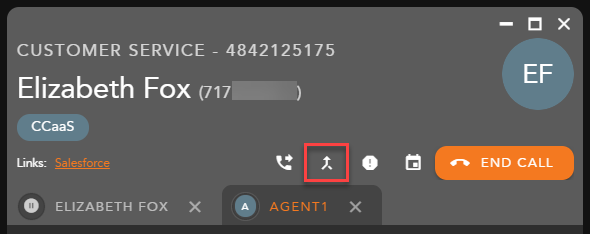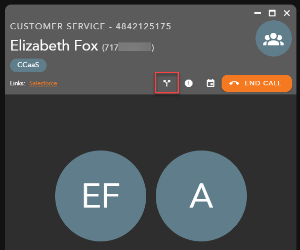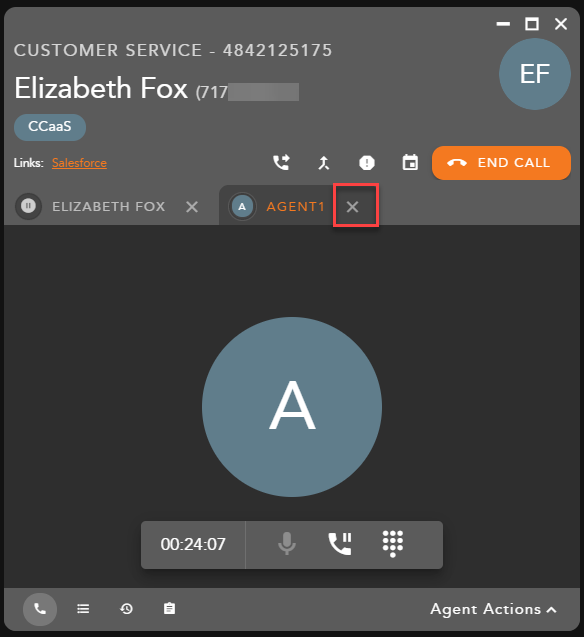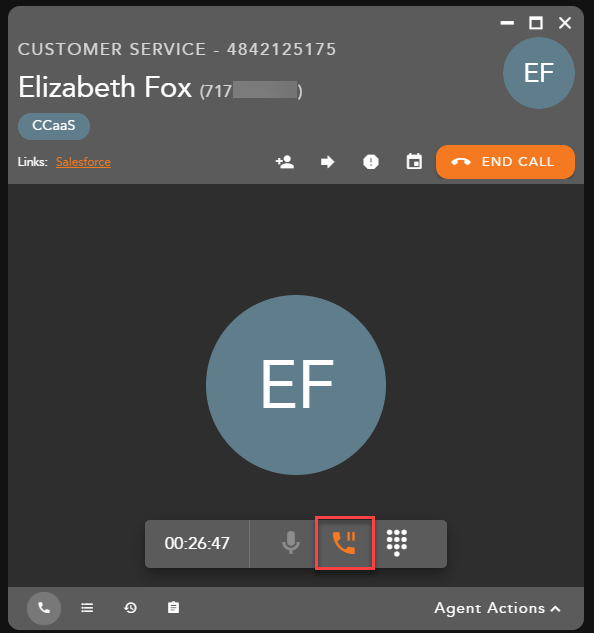Telephony Interaction View
|
|
- Telephony Interaction Header - displays the following information regarding the contact:
- Customer Name and DID
- Originating BP
- Demands - specific demands assigned to the interaction via the handling flow and utilized to assign the interaction to the appropriate agent
- External Links - hyperlink to open to a URL configured in the Setup client. The links can integrate with a CRM or internal knowledge base, which contains specific information about a customer or help documents. By clicking on a link, you will be redirected to the predefined URL, providing more detailed information on the person they are working with or help documentation.
- Consult - initiates a consulted transfer with another Agent, Supervisor, BP, Enterprise user or 10 digit DID. Once the transfer has been initiated and accepted, the ability to start a conference will become available.
- Blind Transfer - initiates a blind transfer to another Agent, Supervisor, BP, Enterprise user or 10 digit DID.
- Add to Do Not Call (DNC) List
- Schedule a Callback
- End Call
- Call Recording Controls - Call recording controls will be available based on the call recording profile assigned to the agent. If the agent is set to always be recorded no call recording controls will be present. Controls will only be present if the agent has the ability to start/stop or pause/resume a recording.
- Hold/Resume
- Dialpad
- Agent Actions - selecting agent actions will change the telephony screen to show the following options:
- Disposition Code - pre-defined code to indicate the outcome of the interaction. These codes are specific to the Business Process and can be customized for each Business Process.
- Completion Status - explanation as to why the interaction ended. A status may be selected during or after an interaction. The completion statuses available will depend on the type of interaction handled
- Remarks - custom remarks relevant to the interaction and customer. Remarks are saved and available for review on the next interaction the customer has with the contact center and can be found in the CRM panel under Notes and Remarks.
- Contact - saved contact information. If the CRM panel is enabled through the Setup client, you will be able to edit an existing contacts information or add a brand new contact to the contact management system if they are new to the contact center.
- History - displays all interaction history the contact had with the contact center
- Notes and Remarks - will display all system and agent added remarks and notes for the contact.
Call Interaction Sidebar
The call interaction sidebar displays your:
- Active Call Interactions
- Call History
Active Call Interactions
The Active Call field displays all active call interactions. Each active call will display the name of the contact and the current call duration
If a call is put on hold the Active Call header will change to On Hold and the active call icon will change to show which call is currently on hold.
Right clicking on an active interaction will provide call control options from the Interaction Sidebar.
Call History
Call history will show all recent historical call interactions, including the customer name, date and time the interaction was handled.
Double clicking on a historical interaction will open the interaction and display the call history, completion status and disposition code applied to the interaction.
Incoming Call Interaction
Accepting a Call
When a new call interaction is being offered to an agent, the call can be answered on either your handset or UC One. The following information will be present for review within the Incoming Interaction Banner before accepting the interaction:
- Interaction Type
- Customer Name and DID
- Originating Business Process
- Interaction Handling Remarks - prepopulated through the Interaction Handling Flow configured in the Setup client. If no remarks are present for the interaction this field will not be visible on the interaction.
- Demands - specific demands assigned to the interaction via the handling flow and utilized to assign the interaction to the appropriate agent.
- Entry Time - the time that the interaction was connected with an Agent.
- Previous Number of Attempts - the number of times that a callback or campaign call was made to the customer number.
To decline and send the interaction back to queue, select . Note, if you are the only ready agent in the BP, the interaction will continue to present itself until accepted or another agent becomes ready.
To accept the interaction via your handset, select . This will work only if utilizing a handset or eAgent Softphone. If the agent is using the agent application with Teams or Webex, the agent must answer the call directly Teams/Webex.
Completing an Interaction
To end a call interaction, select End Call . When a call is ended, if pre-configured in the Setup Client, you will be put into a wrap-up state to complete the call. If no wrap-up has been configured, you will be put back into a Ready state to handle the next queued interaction.
If Wrap-up has been configured, the following options will be available to complete the interaction:
- Wrap-up Timer - counts down the amount of time left in wrap-up
- Disposition Code - apply a disposition code to the interaction. If no disposition codes have been configured for the originating BP this option will not be available. By default, your three most used disposition codes for the originating BP will be at the top of the disposition drop down, followed by all disposition code categories and subcategories.
- Completion Status - end result of the interaction. The completion statuses available will depend on the type of interaction handled.
- Handled - default value for completed interactions. The interaction was completed and handled.
- Delegate to Supervisor - this option is only available if enabled for agents in the Setup Client. Once a call has ended, agents can delegate a call to a Supervisor with remarks attached providing an explanation as to why the interaction has been delegated to a supervisor
- Remarks - custom remarks relevant to the interaction and customer. Remarks are saved and available for review on the next interaction the customer has with the contact center and can be found in the CRM panel under Notes and Remarks.
- To add a new remark to the interaction select . Once selected the remarks field will open to add a new remark.
- To add a new remark to the interaction select . Once selected the remarks field will open to add a new remark.
Once you have filled in the required fields select . This will complete the interaction and put you back into a Ready state. If you do not manually select complete and wrap up is configured, the interaction will complete automatically after the wrap-up period has ended. Once an interaction has completed, it will appear under your call history within the Interaction Panel.
Transferring a Call
Blind Transfer Via Directory
To transfer a call to another Agent, Supervisor, BP, Channel, Enterprise User or DID select the Transfer Icon within the interaction toolbar.
The Transfer window will open and default to Favorites.
Within the search bar you can type the name of the user you wish to transfer the interaction. As you begin to type, the window will filter each category and make available only the contacts that match your search criteria.
Select the transfer arrow to complete the transfer.
The interaction window will disappear followed by a transfer success message.
*Transfers can only be sent to agents and supervisors in a Ready or Handling Outgoing state. If you attempt to send a transfer to a Busy agent, you will receive the following error message:
Blind Transfer Via Dial pad
If you wish to transfer the call to a 10 digit DID, select the Dial Pad Icon within the transfer window.
Type in the number and select the transfer arrow to complete the transfer.
The interaction window will disappear followed by a transfer success message.
Consulted Transfer
To perform a consulted transfer select the Consult Icon within the interaction toolbar.
The Transfer window will open and default to Favorites.
Within the search bar you can type the name or the User (Agent, Supervisor or Enterprise Contact), BP or Channel or manually enter in a ten digit number using the dial pad to transfer the interaction. As you begin to type, the window will filter each category and make available only the contacts that match your search criteria.
Select the transfer arrow to initiate the consulted transfer.
*Transfers can only be sent to agents and supervisors in a Ready or Handling Outgoing state. If you attempt to send a transfer to a Busy agent, you will receive the following error message:
When the transfer has been initiated, your call window will split into two tabs and the customer will immediately be put on hold. The first tab is the established conversation between you and the customer and will display the customer name or ID. The second tab is the initiated consult.
The second tab will initially show a waiting indicator until the end user accepts or declines the call.
|
|
Once the call has been accepted select the transfer icon to complete the consulted transfer.
The interaction window will disappear followed by a transfer success message.
If the consulted party does not wish to take the interaction, exit out of the tab
The call will drop and the call will need to be resumed with the customer.
Initiating a Conference
To initiate a conference call with a third party select the Consult Icon within the interaction toolbar.
The contacts window will open and by default your favorites will be expanded.
Within the search bar you can type the name of the User (Agent, Supervisor or Enterprise Contact), BP or Channel or manually enter in a ten digit number using the dial pad you wish to conference into the interaction. As you begin to type, the window will filter each category and make available only the contacts that match your search criteria.
Select the arrow to initiate the conference.
*If initiating a Conference with an agent or supervisor they must be in a Ready or Handling Outgoing state. If you attempt to initiate a conference with a Busy agent or supervisor, you will receive an error message.
When the conference has been initiated, your call window will split into two tabs and the customer will immediately be put on hold. The first tab is the established conversation between you and the customer and will display the customer name or ID. The second tab is the initiated contact with the third party.
The second tab will initially show a waiting indicator until the end user accepts or declines the call.
|
|
When you are ready to pull the third party into the call and begin a conference, select the Conference Icon found in between the two call tabs.
The tabs will merge into one call window indicating a successful conference and the customers avatar in the header of the interaction will change to indicate an active conference.
Ending a Conference
To end the conference and interaction, select
Splitting a Conference
To split the conference and resume the conversation with the customer, select the Split Conference icon
When Split Conference is selected, the conference will end and split the callers back into two separate calls and tabs within the interaction window.
To end the call with the third party select the exit icon on the tab. When selected, the call will end and the tab will disappear. The original caller will remain on the line. Remove the caller from hold.
